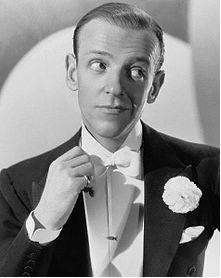Fred Astaire (born Frederick Austerlitz; May 10, 1899 - June 22, 1987) was an American actor, singer, dancer, and choreographer. His career spanned 76 years, in which he made 31 musical films. He is best known for his partnership with Ginger Rogers, with whom he made 10 films. The American Film Institute ranked him as the fifth greatest male screen legend.
Biography[]
Astaire was born in Omaha, Nebraska in 1899 to a mother of Lutheran German descent and a father who had immigrated to the US from Austria. He had an elder sister, Adele Astaire, who also became a dancer. The family moved to New York City in 1905 with the intention of creating a double act for Adele and Fred, based on their emerging dancing and musical skills. The family surname was quickly changed to Astaire to avoid an association with the Battle of Austerlitz. Adele and Fred quickly grew into a successful act, performing before crowds in several major cities. It was during this early phase of his career that Astaire began to adopt his signature clothing style along with his desire for perfection in his numbers.
Upon reaching adulthood, the Astaire siblings achieved moderate success on Broadway that lasted throughout the 1920s. While Adele's dancing and humor continued to command attention, audiences began to be mesmerized by Fred owing to his carefully-planned numbers and unique choreography. Fred soon began to feel constrained by the pairing, and formally split with his sister after her marriage to the Duke of Devonshire's son in 1932. It was also at this time that Hollywood showed interest in Astaire, and he travelled there for an audition for RKO Radio Pictures. Even though RKO heads were disappointed with his tests, they remained confident in Astaire and, after being loaned out to MGM for a brief appearance in Dancing Lady (1933), he was cast in a supporting role in Flying Down to Rio (1933), where he would share a pivotal scene with a rising actress named Ginger Rogers.
The scene in the film between Astaire and Rogers received widespread attention when it was released, leading to popular appeal for the duo to make more musicals together. Astaire was reluctant to start another team after the experiences with his sister, but the popularity of him and Rogers persuaded him otherwise. The duo would go on to star in nine more musicals together, including The Gay Divorcee (1934), Top Hat (1935) and Swing Time (1936). Owing to his control over the dance numbers in the films, Astaire created two innovative techniques for musicals: he eschewed quick cutting in favour of having the camera more closely follow the dancers with as little shots as possible; and instead of staging dances for spectacle in the manner of Busby Berkeley, Astaire used them as devices to move forward the plot.
The Astaire-Rogers musicals were all massive box-office hits, and the partnership is still considered to be among the greatest in film history. When it ended in 1939, Astaire continued to headline moderately successful musicals in the 1940s, appearing opposite other formidable dance partners such as Bing Crosby in Holiday Inn (1942), Rita Hayworth in You'll Never Get Rich (1941) and You Were Never Lovelier (1942) and Gene Kelly, who idolized Astaire, in Ziegfeld Follies (1945). Astaire initially intended to retire from film-making in 1946, but that decision was quickly reversed when he was hired to replace Kelly in Easter Parade (1948) when the latter was injured. Its success ensured that Astaire's popularity remained high into the 1950s, with The Band Wagon (1953), Funny Face (1957) and Silk Stockings (1957) being among his greatest hits from that decade. However, he suffered a personal tragedy during production of Daddy Long Legs (1955) when his wife Phyllis suddenly died from cancer. A deeply devastated Astaire wanted to can the film and pay all the production costs himself, but he was persuaded to go ahead with the musical.
Toward the end of the 1950s, Astaire moved away from musicals to perform in serious cinematic roles. He appeared in the drama On the Beach (1959) about the devastating aftermath of a nuclear conflict, the disaster film The Towering Inferno (1974) about a skyscraper catching fire (for which Astaire received his sole Oscar nomination, in the category of Best Supporting Actor), and the supernatural horror Ghost Story (1981) which marked Astaire's final screen appearance. The last time Astaire danced on film was in Finian's Rainbow (1968), an early offering from Francis Ford Coppola.
Astaire died in 1987 of pneumonia, aged 88. His reputation remains in high esteem, with many considering him to be the greatest dancer in Hollywood history; his innovative methods of filming and constructing dance sequences are believed to have revolutionized the film musical. Astaire was named as the fifth-greatest male actor of classic Hollywood by the American Film Institute in 1999.

